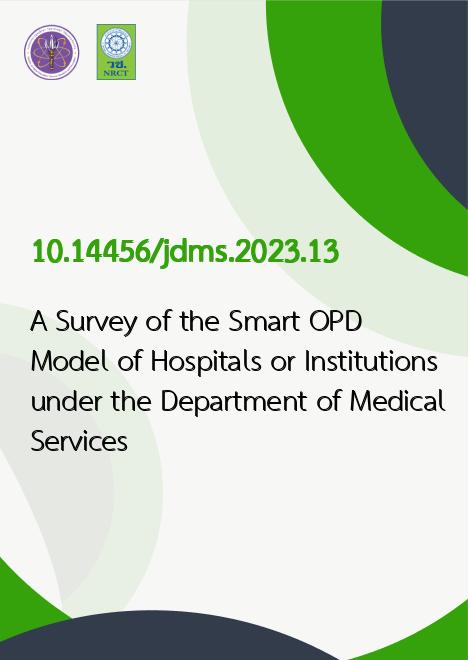
|
A Survey of the Smart OPD Model of Hospitals or Institutions under the Department of Medical Services |
|---|---|
| รหัสดีโอไอ | |
| Creator | Jiranda Krairittichai |
| Title | A Survey of the Smart OPD Model of Hospitals or Institutions under the Department of Medical Services |
| Publisher | สำนักวารสารกรมการแพทย์ |
| Publication Year | 2566 |
| Journal Title | Journal of the Department of Medical Services |
| Journal Vol. | 48 |
| Journal No. | 1 |
| Page no. | 104-113 |
| Keyword | Expectation, Healthcare facilities, Smart OPD |
| URL Website | https://he02.tci-thaijo.org/index.php/JDMS |
| Website title | วารสารกรมการแพทย์ |
| ISSN | 2697-6404 |
| Abstract | Background: The public's perception of public hospitals was one of congestion and overcrowding of patients. Due to these problems, the Department of Medical Services set a policy highlighting the development of the outpatient service (OPD) system for hospitals and institutions. This policy was to build hospitals and institutes to be the "Smart OPD" which were a quality, standardized, clean, comfortable, and aesthetically pleasing level of services. Objectives: To investigate the "Smart OPD" service's performance in hospitals or institutions that are under the Department of Medical Services from the perspective of patients' and family members' expectations. Method: This study used Google Forms as a survey tool for collecting information from 31 institutes and the people who received services during a six-month period (3 January30 June 2020). Result: 1) 31 institutes passed the Department of Health's "green and clean" standards and 14 of them were institutes in Bangkok that passed the "Bangkok Green and Clean Hospital Plus" (BKKGC+) criteria (100%). 2) There were 31 (100%) institutes that arranged the place to look modern (a digital look) by developing an application for public service. 3) 27 institutes (87.10%) collected patient medical records, and Electronic Medical Records (EMR). 4) 27 institutes (87.10%) no longer required the request for copies of ID cards or other documents issued by the government. 5) 31 institutes used electronic prescriptions (100%). (6) 29 institutes (87.10%) collected information about the duration of outpatient services in every clinic. 7) 30 institutes (96.77%) had an organized online system regarding payment of services, medicines, or other procedures. 42.04% of the institutes provided services that were higher than clients' expectations, 54.80% as expected, and 3.16% were in need of improvement. Conclusions: Expected results of service recipients (outpatients) at hospitals and institutes under the Department of Medical Services in high expected and the expected level was 96.84% after the "Smart OPD" policy. |